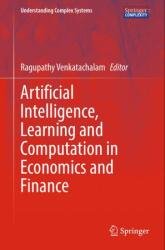 Название: Artificial Intelligence, Learning and Computation in Economics and Finance
Название: Artificial Intelligence, Learning and Computation in Economics and FinanceАвтор: Ragupathy Venkatachalam
Издательство: Springer
Год: 2023
Страниц: 331
Язык: английский
Формат: pdf (true), epub
Размер: 41.1 MB
This book presents frontier research on the use of computational methods to model complex interactions in economics and finance. Artificial Intelligence, Machine Learning and simulations offer effective means of analyzing and learning from large as well as new types of data. These computational tools have permeated various subfields of economics, finance, and also across different schools of economic thought. Through 16 chapters written by pioneers in economics, finance, Computer Science, psychology, complexity and statistics/econometrics, the book introduces their original research and presents the findings they have yielded.
Algorithmic thinking is gradually becoming an indispensable feature of Economics and Finance. Computational modes of thinking increasingly influence how we model individuals, organisations, market interactions and macroeconomic dynamics. Consider some topics that are traditionally of interest to economists and scholars of finance: decision-making by economic actors; mechanisms through which agents learn, adapt and thrive in uncertain, complex environments; the impact of economic decisions by individuals, firms and institutions on others in an interconnected system; emergence and diffusion of innovations; understanding volatility in financial markets; modelling aggregate, macroeconomic dynamics and associated pathologies (inflation, unemployment, inequality); and modes of exercising control through policy. All these issues are being studied using computational methods to varying degrees within the field.
Computational thinking in Economics and Finance can take diverse forms, ranging from straightforward applications of computational tools to analyse economic data, study properties of theoretical models (e.g., Computable General Equilibrium models), simulate large-scale Agent-Based Models (ABMs) and network models, perform numerical simulations, investigate game-theoretic scenarios; all the way to developing full-fledged algorithmic frameworks such as computable economics.
Computational methods and simulations are heavily relied upon to perform counterfactual thought experiments in ways that surpass the barriers posed by traditional mathematical and statistical tools. On the empirical front, Machine Learning (ML) and simulations have offered effective methods to analyse and learn from new types of data. These computational tools have permeated various sub-fields of Economics, Finance, and different schools of economic thought.
The question of what really constitutes AI continues to be debated. We prefer to take a broader, more plural view of AI to cover a broad umbrella of concepts, approaches and tools. These include: symbolic and sub-symbolic, connectionist approaches to AI, a range of Machine Learning methods such as supervised learning (e.g., artificial neural networks, nearest neighbour methods, kernel smoothening, probably approximately correct (PAC) learning, tree-based methods, classification algorithms, and support vector machines), unsupervised learning (e.g., self-organising maps, k-means, clustering), semi-supervised learning, ensemble learning (e.g., random forests), reinforcement learning, Deep Learning, natural language processing (NLP), evolutionary computation, ABMs, causal inference tools, ant algorithms and swarm intelligence.
Contents:
1. Computational Thinking in Economics and Finance: Introductory Remarks
2. Uncomputabilities, Games, Axioms, Proofs and Artificial Intelligence
3. Logic and Epistemology in Behavioral Economics
4. Agent-Based Computational Economics: Overview and Brief History
5. Sequential Monte Carlo Squared for Agent-Based Models
6. Toward a General Model of Financial Markets
7. Sand Castles and Financial Systems: A Sandpile Metaphor
8. A Systematic Review of Investor Attention: Measurements, Implications, and Future Directions
9. What is the Market? The Essential Teachings from an AI Market Experiment
10. Market Power and the Hayek Hypothesis: An Experimental Investigation
11. Counterfactual Thinking and Causal Mediation
12. When Supply and Demand do NOT Meet: Sraffa’s Critique of Economic Theory Restated
13. Visualizing the Roles of Frequent Terms in LTEs Following Two Economic Crisis Trigger Articles
14. Design and Performance Metrics for Autonomous Human-Machine Teams and Systems (A-HMT-S)
15. Thirty-Five Years of Computational Economics
16. Extending Herbert Simon's “Science of Design”: the Role of Collaboration and Users in Development of Technically Advanced Systems
Скачать Artificial Intelligence, Learning and Computation in Economics and Finance